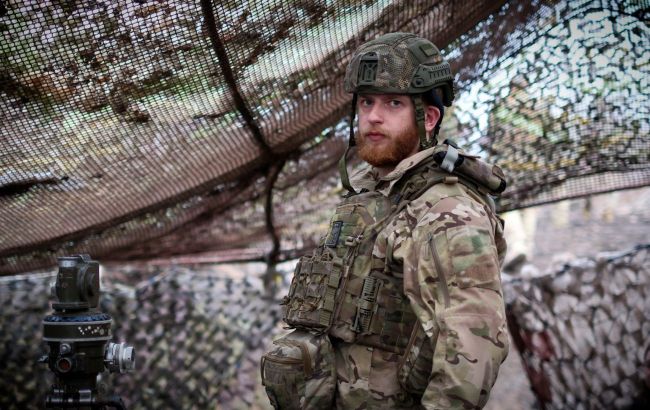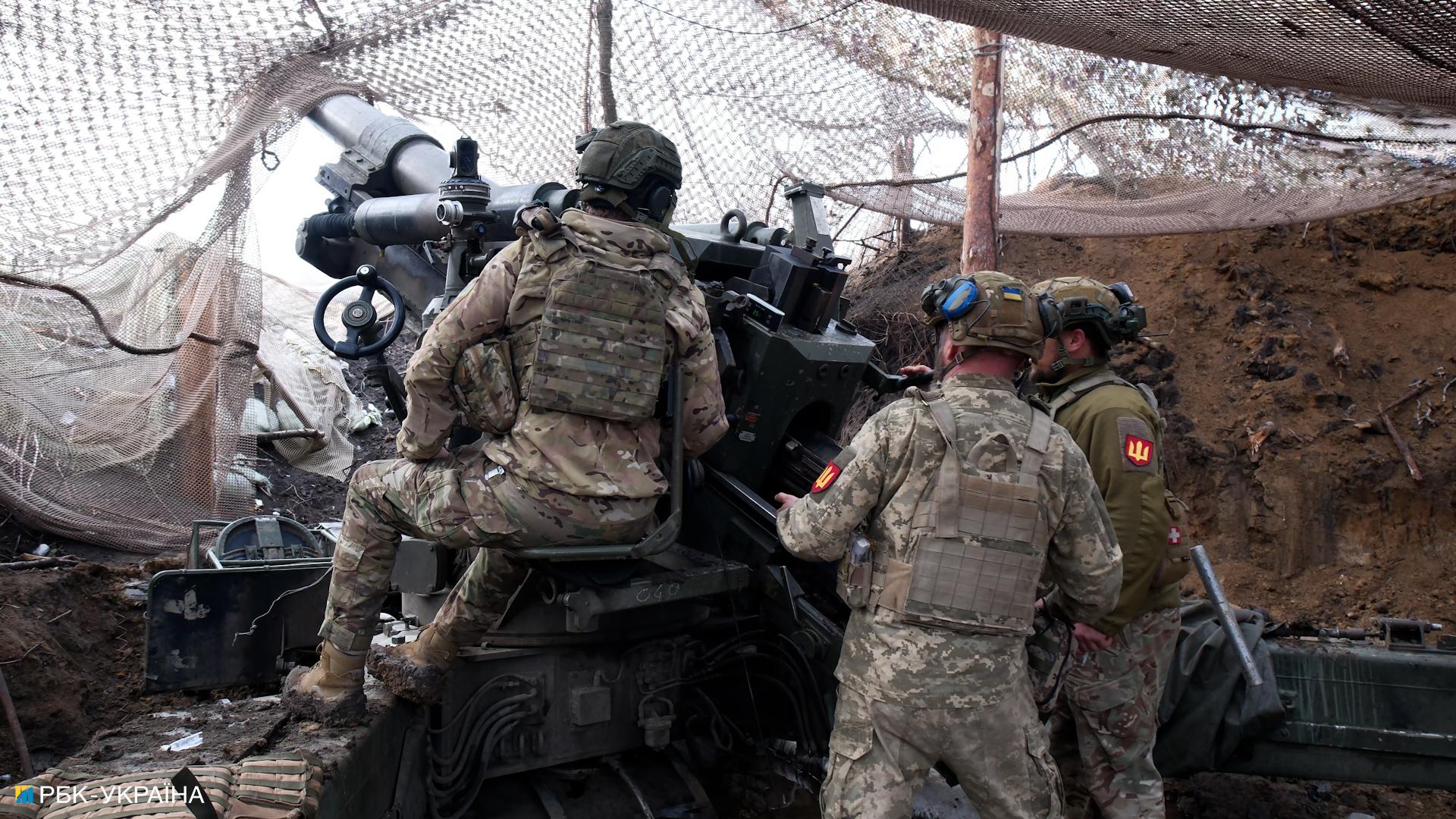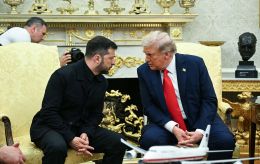Two days with Ukrainian artillerymen: Report from Zaporizhzhia frontline
 Ukrainian artilleryman (photo: Vitalii Nosach/RBC-Ukraine)
Ukrainian artilleryman (photo: Vitalii Nosach/RBC-Ukraine)
From a self-propelled Bohdana to a NATO FH70 howitzer, RBC-Ukraine journalists spent two days at the 44th Brigade's artillery positions. A report from the front line, where Ukrainian artillerymen are holding back Russia's advance in the Zaporizhzhia sector.
Day one. Departure with Bohdana self-propelled howitzer
We wake up at dawn. Some of us had time to sleep, some didn't, but the general mood is fighting. At the assembly point, we are waiting for the military to take us to the place of deployment. The sky is pink in the morning, and the air is fresh and spring-like. For a moment, it seems that we have arrived somewhere on vacation, but the barely audible sounds of gunfire bring us back to reality and remind us that there is a war going on not far away.
The next two days, we will spend with the artillerymen of the 44th Brigade of the Armed Forces of Ukraine and test their weapons. On the first day, we will get acquainted with the self-propelled artillery systems. Here, in the Zaporizhzhia region, our Bohdana, a Ukrainian self-propelled howitzer, is operating.
The Bohdana self-propelled artillery system is a Ukrainian 155 mm wheeled self-propelled artillery system designed following NATO standards. It is designed to destroy enemy artillery, firing positions, control points, vehicles, warehouses, and manpower at a considerable distance.
The self-propelled system was developed in 2018 at the Kramatorsk plant. It was widely used during Russia's full-scale invasion of Ukraine. We currently have more than 180 units of this equipment in service. The Bohdana received its first baptism by fire during Russia's full-scale invasion of Ukraine on Zmiinyi Island.
On the road, one of the soldiers tells us the history of the area. In civilian life, he was a historian, so he knows a lot about the Ukrainian lands.
"Now here the front line runs along the mounds of our ancestors," he says.
"We find a certain symbolism in this - our great-grandfathers, who are buried here, also defended their land in their time.

Photo: RBC-Ukraine
By the time we get to the positions, the weather has changed dramatically - the sun is covered in clouds, and it starts to rain. But this does not mean there will be no work, as artillery works in any weather. The Bohdana team speaks very carefully of this huge iron machine.
"For us, it's like an armored brother: it shoots accurately, reacts quickly, and doesn't require manual folding of the gun bed, like the Soviet ones," the gunner laughs.
The guys have enough work to do in this area, as the Russian forces are constantly using both infantry and various types of equipment. Sometimes, there is not even enough time to take a break.
"As soon as we arrive, the Russians already have the coordinates. Rotation, movement, new positions - it's all familiar. Once we entered a village, and as soon as we stood there, we received an interception on the radio: the coordinates were transmitted. As soon as we hid in the thicket, it was already flying. We were running from place to place that day. It was both funny and scary," recalls one of the guys.
The work on Bohdana is standard, just like in other self-propelled howitzers. Going to a firing point, hitting a target, and quickly rolling back because Russian guns can fire back.
"When the guns are silent, it does not mean there is peace. We are practicing infantry, mortars, and vehicles. We are working with cluster munitions at 30 kilometers for accuracy. We get the coordinates, shoot, and retreat. We spend five, ten, maximum of twenty minutes at the position," says the commander.
The crew of the self-propelled gun has been fighting for a long time, and almost all of them joined at the beginning of Russia's full-scale invasion of Ukraine. Some have been fighting since the ATO (Anti-Terrorist Operation - ed.). But most of them had nothing to do with the military before the war.
"I am a potter. And now I am a driver of the Bohdana self-propelled howitzer. My task is to bring the cannon to the position and take it away. Everything has to be fast," says the howitzer driver.
The man had a creative profession and left it on the first day of Russia's full-scale invasion of Ukraine. His sons followed him later. The elder joined the Azov brigade, and the younger entered the military academy.
While we are talking, we hear the military radio the command "to fight". The crew quickly moves to their positions. The weather is terrible, the rain is intensifying, the mud is crushing underfoot, but you don't feel any discomfort - you want to see Bohdana hit the target.
The vehicle growls and stops in position. The cannon rises above the cab. Each soldier presses the levers of the self-propelled gun while sitting on his seat - the Bohdana is fully automated. The last seconds of aiming - and the shot. First, we see a flash of fire, and then we hear it. A loud bang of thunder spreads across the sky.
 Photo: RBC-Ukraine
Photo: RBC-Ukraine
Later, the scouts report on the radio about the targets they hit. The guys are listening, but they keep telling us in a refrain that Bohdana does not miss, so it is extremely important to have as many Bohdanas as possible.
"There was a case when we fired three shots at the coordinates. All three of them hit the target. The infantry later reported that we had taken out the mortar position, and it became easier at the contact line. At such moments, you feel that you are not working in vain," says the gunner.
Day two. FH70 - different gun, same fire
The next day, we went to another unit of the 44th Air Assault Brigade to the position of the FH70 howitzer. It's also a NATO model - although self-propelled, its mobility is slightly lower than that of the Bohdana. However, its accuracy and range are at a high level, and the soldiers have already mastered it well.
On the way to the positions, we notice the posts along the roadside. According to the soldiers, they are going to set up netting against drones. The situation here is similar to the one in the Kursk region, there is only one logistics route. And the Russians are actively trying to hit it with drones. In the Kursk region, the only road to the combat positions was called the road of life because of the high risk. We want to believe that this road in Zaporizhzhia will not be named the same.
Zaporizhzhia remains one of the priority targets for the Russian forces. So now they are again trying to intensify their offensive in this area. In addition, there is a possibility that the Russian army may deploy North Koreans here.
According to intelligence reports, several heavy artillery pieces from North Korea, the Koksan, were recently transported by rail to the northern part of Crimea. This may indicate that North Korea's military is rotating to other parts of the front. In particular, given the logistics, it is likely to be the Kherson and Zaporizhzhia regions.
 Photo: RBC-Ukraine
Photo: RBC-Ukraine
On the way to the firing positions, we notice quite a few civilians. Despite the danger and constant shelling, people do not leave their homes. In some places, chickens are grazing on the porches. One of the soldiers says there is a local woman who even keeps goats.
"We know this village well. There used to be a shop here, but now everything has moved out - everything is coming here. Shops don't survive fire," the driver says.
Today, the weather is more favorable to us. It is not raining, the sun is already drying up yesterday's mud. But at the same time, it is not too good, because such weather is favorable for unmanned aircraft, both reconnaissance and strike.
Nearby, we find parts of a downed Russian Lancet. The engine is metal, and the frame is made of cheap material that looks more like foam covered with film. This proves once again that Russian drone production is more focused on quantity than quality.
We go down to the artillerymen's temporary home. Despite the dampness, the basement is warm and cozy. As it often happens, a cat has found its way to the men and immediately feels like a master here. As if by custom, before a combat mission, we are treated to hot tea and sweets, while the soldiers talk about their work.
"Our one gun was very accurate. I hit the target with the first shell. This is a rare thing. But when it happened, the commanders applauded," the gunner boasts.
The FH70 field howitzer was developed back in the 1970s by three countries - the United Kingdom, Italy, and Germany. The partners handed it over to Ukraine during the war. The soldiers say it is a powerful weapon that can accurately destroy vehicles at a distance of up to 30 kilometers. So it is possible to hit Russian targets deep in Russia's rear.
"One day, a Russian armored vehicle with an ammunition package was driving by. Six shells, and it caught fire. Beautifully, slowly. We were waiting for the ammunition to detonate. When they detonated, a fire mushroom grew in the sky," the howitzer commander recalls, picturing the flash with his hands.
 Photo: RBC-Ukraine
Photo: RBC-Ukraine
Artillerymen can see the fruits of their labor only after some time, so when they send a video of the damage, they say they get together and watch it like a movie. In addition, the gunners never see the target, and sometimes they do not know what exactly they are hitting, because they are guided by a busola, or as the fighters themselves call it, a stick.
"I look at the red stick all day long. This is my horizon. If there is a stick, we shoot. If not, we twist it around and look for it. Then we fire. Loud, powerful, and deadly accurate," the howitzer gunner laughs.
It is quite difficult to maintain a 155-millimeter howitzer because it is a large-caliber weapon. We are trying to lift one ammunition - it is impossible, it is too heavy.
"My main job is to put the shell on the tray and load it into the barrel. It weighs 40 kilograms. Sometimes you lift 50-80 of them in a day. It is physically very hard," the soldier explains.
Being an artilleryman is hard work, although there is no such thing as easy work in war. Exhaustion is a common thing here. "We sit, then - "Salvo!" - and again silence. Until we get new coordinates," says the commander.
Everyone understands why they are here, knows what they are fighting for, and for whom. Everyone sees their scenario for the end of the war, which generally converges into one - to prevent future generations from fighting.
"I have three children. I'm here so that they never see war," says one of the fighters.
"We don't want to be heroes, we want a normal life. We want our children to know that their father fought and won. So they don't have to," adds another.
***
Today, only a few of those who went to war in the early days remain at the front. They, like all soldiers, say they have their questions, dream of rest, and just want to get a good night's sleep. And then the command "Charge" comes over the radio.
"Angle 23-90, level 25-75, charge!"
We hear "fire" on the radio. Again, we are like spellbound, chained to the gun. And again, we see a flash at first, and then we hear it.

